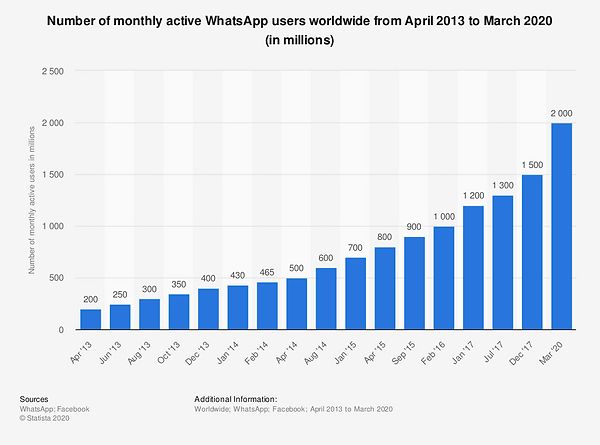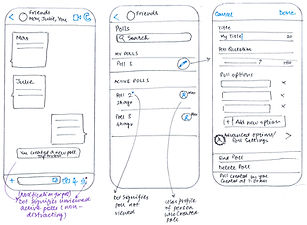WHATSAPP - POLLS
A design project to explore Polls as a new WhatsApp feature and the value it can bring.
WhatsApp is a cross-platform text and voice messaging application that launched in 2009. It is offered as a free application and uses a phone’s cellular and Wi-Fi connection to enable messaging and calling which makes it easily accessible to a large number of users.
WhatsApp is used for sending messages, making voice and video calls, sharing pictures, documents, locations, and other media. The challenge was to design a solution that would enable WhatsApp Groups to allow for a quick and easy decision-making workflow.
THE PROBLEM
Using WhatsApp Group Chats to seek members' opinions for the purpose of planning an activity or get group consensus is a tedious process.
While WhatsApp provides a seamless experience to the users for sharing messages, photos, and videos, the experience of planning an activity or getting consensus in a WhatsApp group often causes confusion and chaos.
As an avid WhatsApp user, I frequently use WhatsApp to plan group events with my friends and family and I have found the process to be extremely time-consuming. This frustration led me to envision adding a polling feature to WhatsApp groups to create a better experience of planning within a WhatsApp group.
HIGH LEVEL TIMELINE
This project took 3 weeks to complete.
MAKE OF THE TEAM
Personal Project. I played the role of the researcher and user interface designer.
KEY GOAL
The goal was to improve the decision-making experience in WhatsApp groups.
PROCESS
I followed IDEO's Human-Centered Design process and ensured that my design decisions were inspired and validated by user research.
I followed an iterative process to understand the user needs and desires, testing my assumptions, and redefining the problem to explore possible alternate solutions. The design thinking process helped me develop empathy with the target users and solving the problem in human-centric ways.
DESIGN PROCESS
EMPATHIZE
DEFINE
IDEATE
PROTOTYPE
TEST
RESEARCH
As of 2020, WhatsApp has over 2 billion users in over 180 countries which makes it the most popular messaging app in the world followed by Facebook Messenger.
WhatsApp Group Chats are one of the most heavily used features of WhatsApp where users can keep in touch with groups of people, like family, friends, neighbors, and share messages, photos, and videos with up to 256 people at a time.
I conducted an online survey with my WhatsApp group members including family and friends to understand their usage motivations and needs. Based on the survey, the top 3 reasons for using WhatsApp were: connecting with family & friends, planning events, and sharing pictures.



EMPATHIZE & DEFINE
In order to dig deep into understanding the users and creating solutions that would not only solve a problem but improve the users' lives by removing any frustrations or hurdles, I used techniques such as storyboarding, persona creation and empathy mapping to build understand and empathize with the users.
Storyboarding
I used storyboarding to get a bigger picture of the problem and the people I am designing for. This helped me to focus on designing a better experience for the users. Through storyboarding, I envisioned a simpler and easier process for users compared to what they currently do.

Personas
Based on the user interviews I conducted and observing the social groups I have on WhatsApp I created proto personas to help guide my decisions throughout the user journey.
I identified 2 primary personas for this user flow: the Doer and the Observer.
With user research, I identified that the people in WhatsApp groups mostly fall into one of these categories.
Persona A - The Doers are the active people in the group who take the initiative to plan things and stay connected.
Persona B - The Observers generally do not initiate an activity or event within the group but are willing to participate.


Empathy Mapping
In order to understand the user needs further, I decided to use the technique of empathy mapping. This also helped me to illustrate and collectively show the user research findings from the survey I conducted and to visualize the attributes of the personas I created earlier.

Job Stories
The user research and the empathy mapping results then led me to utilize the Jobs to be Done methodology to create Job Stories to understand the motivation of users, the situations that trigger that motivation, and the expected outcome. It helped me to understand the possible causes for a user's action and the better outcome they were expecting.
Here are a couple of job stories I created based on the interviews conducted with WhatsApp users. I created this job stories following the structure of Situation, Motivation, Outcome
1. When I have to organize a birthday party for my friend, I want to get everyone's availability and choice of location in our friends social circle, so that I can quickly plan other details for the event.
2. When I want to plan a special meal with my extended family, I want to find everyone's food choices and/or any food restrictions/ allergies, so that I can plan the menu to meet everyone's needs and liking.
3. When an office party is approaching, I want to finalize what dress to wear to the event, so that I can feel confident.
Based on the job stories above and my findings of the tasks that users usually perform using WhatsApp, I created few scenarios to help me with the usability study for the future version of WhatsApp I envisioned:
1. Your friend - Amy's birthday is approaching and you want to plan a birthday party for her. Plan among your friend group and decide a place to meet for lunch to celebrate your friend's birthday.
2. Your friend - Jake has created a poll in your WhatsApp Friends group. Check out the poll and send your vote.
3. You have created a poll, edit the poll, and extend the poll deadline by 3 hours.
4. Your friend created a poll and you could not send your vote in before the poll expired. Find out the results from the poll after the poll ended.
IDEATE
As the next step, I turned to paper and pen to draw out design variations, test the user flow with paper prototypes, and also to validate the assumptions I made based on the user study exercises conducted earlier.
Paper Sketches
I created a few paper and pen sketches to demonstrate the design variations and see how users respond to different design variations, find out if they have a strong like/ dislike for a certain design element, and understand the reason behind that. By doing this I was able to quickly prototype alternate design solutions and narrow down the design features I needed to include before moving to design the high-fidelity prototypes.



Paper Prototype
I shortlisted the design variations based on user feedback with the paper sketches and created some screens to do paper prototype testing with few users. This allowed me to do some basic validation about the user flow, any struggling points, and any scope of improvement with the current design. This technique helped me to understand the user flow for the new feature design with quick iterations. It was also a good way of validating how the old married into the new, how familiar and consistent the screens felt to the user as compared to the WhatsApp application they currently use.

PROTOTYPE
The paper prototyping helped me clarify the user flows for different scenarios which can come into action while using the polling feature of the WhatsApp groups. I used Abode XD to create the mockup screens and created a clickable prototype for the user flows.
Poll Creation




Poll Voting

Alternate way of accessing poll - Helpful when user needs to view multiple polls or the Group Chat is flooded with messages and polling menu requires lot of scrolling.

Editing Poll

Poll End & Summary

TESTING
I built a prototype using these mockup screens and conducted live zoom sessions with few users asking them to complete certain tasks. These helped me validate the designs, observe their familiarity with the WhatsApp interface, and how consistent were my designs compared with the existing mobile app. This exercise also revealed some important findings mentioned below.
Here is a clickable prototype I shared with users for testing:
Key Findings
-
Users felt the design consistent in look and feel with the existing iOS WhatsApp application. They intuitively accessed the additional options in the group chat menu when asked to create polls, although they did prefer having the shortcut poll icon as well.
-
The use of dot for unread/ unvoted polls was perceived useful. Users were able to connect it to the way WhatsApp status messages show the dot icon to denote unread posts.
-
Almost all users wanted to vote for the poll they created right away. My initial designs only showed notification on the group menu but with this feedback, I included the poll options in the chat as users wanted to vote and discuss poll options in the group chat window.

MOVING FORWARD
WhatsApp is one of the most popular social media applications and it owes its popularity to be easily available and accessible to people in several countries. The idea of enabling polls in WhatsApp is a step forward in the direction of enhancing the capabilities of this application to improve the day to day lives of its users, help them to save time and make better and more informed decisions.
Few things that I did not cover in the scope of this project but would love to explore in the future are - interviewing more users to understand their frustrations, enable users to add location, dates, other media in poll choices, giving more details about the chosen option like address and images on the poll conclusion, suggesting contextual action based on poll results like adding a calendar event, making reservations, showing flight information. I wish to explore them in detail and think about how to elevate the technology we currently use to make our lives more meaningful.